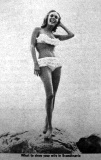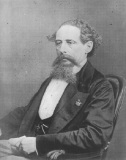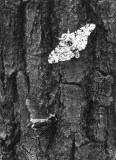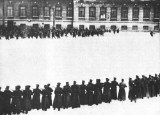I've been a bit lazy about posting on the blog for the past few days, but that doesn't mean I haven't been working on the site! I've actually been adding lots of content to the
Hoax Photo Database. Here are a few of the photos I've added recently:
 The Vanishing Belly Button
The Vanishing Belly Button
Back in 1964 the LA Times ran an ad for Scandinavian Airlines showing a blonde model posing on top of a rock. Strangely, the Times felt the need to remove the model's belly button... because a belly button might have been too provocative for its readers!
 Dickens in America
Dickens in America
Back in 1867 the Mathew Brady studio in New York produced this doctored image of Charles Dickens. We'd call this photoshopping today, but back then everything had to be done in a darkroom. It's a good example of image doctoring from early in the history of photography.
 The Peppered Moth
The Peppered Moth
H.B.D. Kettlewell's photos of (dead) moths on trees are probably the most famous example of scientific photo fakery.
 Bloody Sunday, 1905
Bloody Sunday, 1905
For decades this image was included in Soviet textbooks, where it was described as an actual photo of the "Bloody Sunday" massacre that occurred in St. Petersburg, 1905, when the police opened fire on workers marching toward the Tsar's Winter Palace. In reality, the photo was a still from a 1925 movie.

 The Vanishing Belly Button
The Vanishing Belly Button Dickens in America
Dickens in America The Peppered Moth
The Peppered Moth Bloody Sunday, 1905
Bloody Sunday, 1905
Comments
My school history textbooks were illustrated with many paintings and drawings of events such as the Battle of the Alamo or the Mayflower Compact, yet no one mistook them for photojournalism.
I think the most notorious photo hoax of recent years was Time Magazine's artificial darkening of O.J. Simson's face when they put him on the cover for a story about his murder trial. I guess they thought the real Simpson didn't look evil enough, and in frequently in art dark = evil.
True. But I think false captioning has an important place in the history of photo fakery. A photo without a caption is often meaningless. So creating a misleading caption is just as deceptive as altering the image itself.
It was the Intelligent Design advocates that kicked up the fuss about the photos, in an attempt to lead people to believe that one prominent case that established evolution was based on false info. Nothing of the sort had occurred - Kettlewell did not use the photos as any part of his research, nor were they offered as supporting documentation except, as noted, for illustrative purposes. And such practices are widespread in photography - insects are not the most obliging of subjects. The point wasn't, "Look, I caught two photos of two varieties in great circumstances!" but instead, "This is a comparison of the relative camouflage characteristics."
By including these as "hoax" photos, you're perpetuating the misrepresentation fostered by the Discovery Institute. This really belongs on your "hoaxes about hoaxes" page.